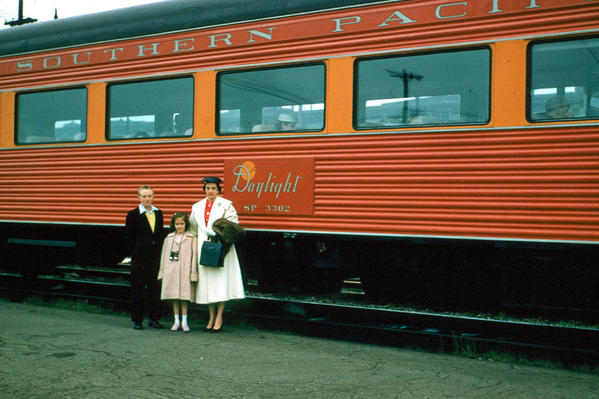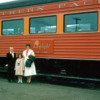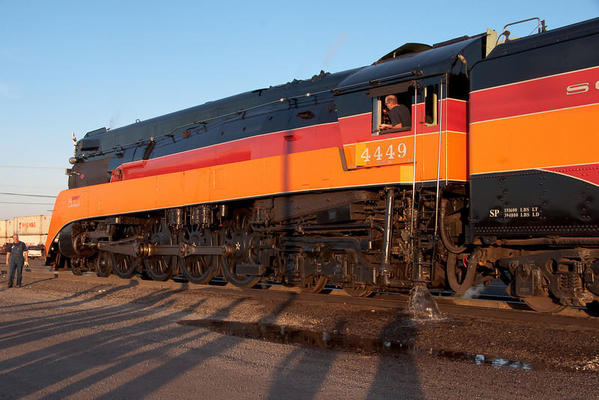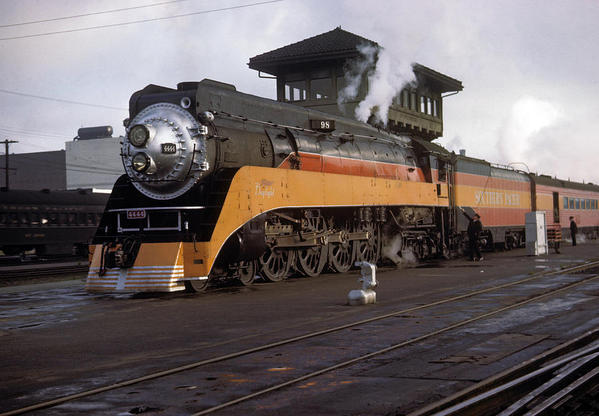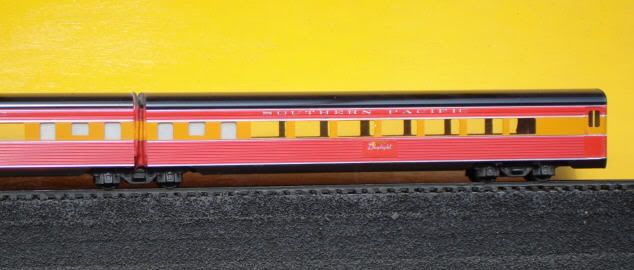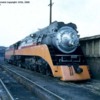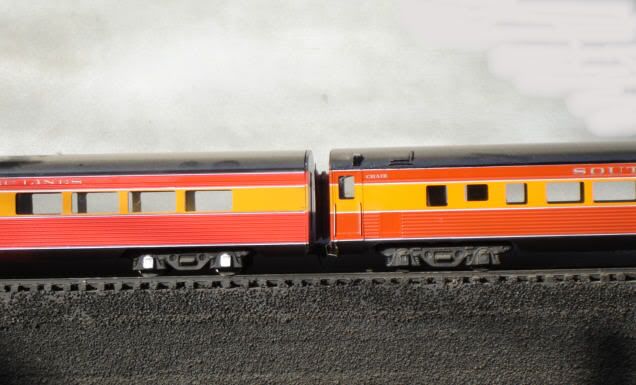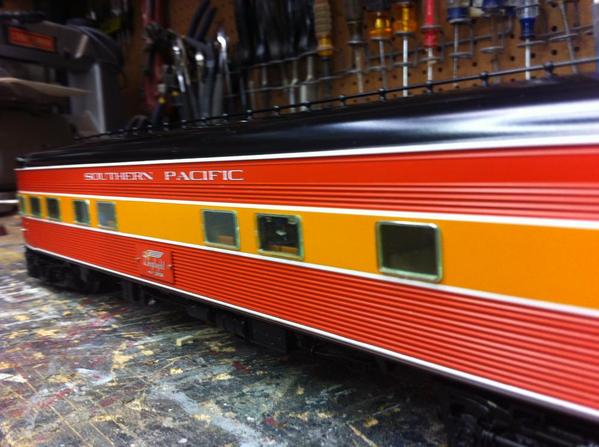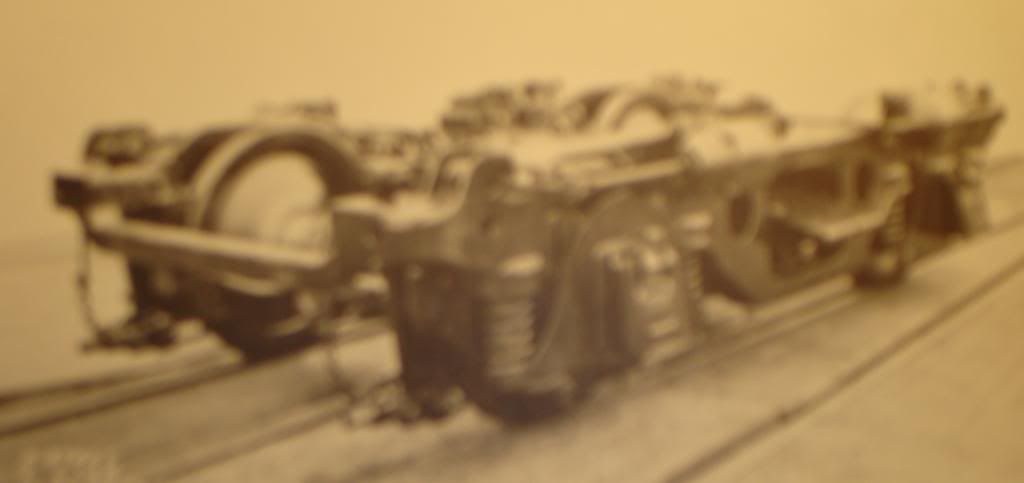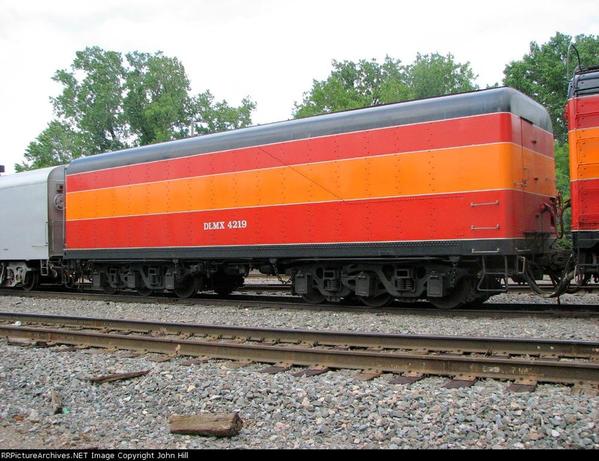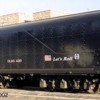I really appreciate it, just want to see for sure before spending the $100 I think it is for 4 of them (3 for my set and 1 in case I buy an add-on section in the future).
Man you sure like to stir the pot! I'm almost afraid to ask.... who exactly do you think did get the color right, besides the same pictures you continue to pick out from the 1000's online?
Ho ho. It's just colors! However, it's interesting to check the hundreds of Daylight shots at RailPictures.net - see what you think. Based on those, the vast majority show the Daylight colors as quite bright, not dull. As mentioned earlier, also check Pentrex Daylight videos. Good stuff.

So have you just been ignoring everything the professionals have told us so far or....?
another picture of a modern daylight with fresh paint, wash job, and an over exposed picture because they posted it online..... dam dude, give it a rest already! you just continue to prove my point that you quoted!
I'm sure this one is wrong too, from 1956. An "in service" car, without a fresh wash, wax, over exposed picture, a private excursion train, or on it's way to the World Fair.
Attachments
Uh oh, stop the press, none of these 3 match, they all must be wrong. The orange is yellowish...the orange is brighter than the red...old pictures, no over exposure, no Photoshop.... Southern Pacific must have painted all their own equipment the wrong color! ![]()
![]()
Attachments
Well...looks like the "Rib Caper" has been solved! Still...a lot of our modeling and models are based on what the eye actually sees. Most of us are not going to be observing any of the manufacturer's cars at a distance of a few centimeters or inches. From the perspective of where I look at my trains, the ribs on the cars I have "look" like some of the prototype pictures I have seen...even though it is obvious from the contributions above that they must be inaccurate. Still...I enjoy my K-Line cars and can appreciate even more the effort that was made to match the prototype colors as it appears they came pretty darned close based on the confirmed accuracy of the GGD colors. I usually run my set with the K-Line SP E-units and it makes a magnificent train especially when I consider that it fit the budget at the time....around 50.00 per car during the blowout period right after K-Line's demise. I am really enjoying this thread and over time, I may be on the lookout for the GGD set as I think my favorite cars in the set would be the articulated ones which K-Line did not model.
Alan
Here is my articulated coach. My ribbon pre- dates GGD. It is spring-loaded to snap in after the cars are dropped innplace on the king post. Minimum radius 74", which is O-148 on this forum.
Color is easy - you don't like a color, you can easily repaint. Corrugations - if you look at the real car above, there is no doubt that size of corrugations alternates. I have many prototype photos, and now enough info to actually measure for correctness.
And trucks - I believe the GGD trucks may be the best so far, but for dimensional accuracy I believe the sand-cast Lobaugh trucks in my photo top everything else available. Note on the previous page the well for the coil spring on the journal housing.
Too bad that the bellows-style diaphragms had to be the way to go on the GGD cars. Not prototypical at all, but I suppose it's better than a gap. I still have to order some for my set, although personally I feel that GGD should have offered those to customers as a free upgrade since the cars should have had them in the first place, IMO.
And BTW, the fluting on the observation car is consistent; the appearance of alternating flute sizes is due to a trick of the light.
Paint color can vary so much depending on the exposure of the photo, to paint fade, dirt and so on. I just say to the manufacturers...get it close and I'm happy. ![]()
Attachments
And BTW, the fluting on the observation car is consistent; the appearance of alternating flute sizes is due to a trick of the light.
They definitely should be alternating to be prototypical. That same trick of the light is what highlights it in that photo. As Laidoffsick and I were discussing earlier, it's incredibly hard to see with the naked eye but it looks like GGD definitely got the alternating corrugations correct.
If you see it plainly on the prototype, and have to strain to see it on the model, it probably is not correct. I have no problem seeing the alternating corrugations on Kasiners, Speers, and K-Lines. Some say the Pecos River cars were the best, but in spite of this possible problem I believe the GGD cars are better. That's an opinion, and would be blasted on some other forums.
It would seem certain lighting conditions are required for the GGD alternating rib size patterns to be plainly visible, as they were to me in John Korling's photo. When under the harsh fluorescent lighting in my train room however they become very difficult to see as Laidoffsick also discussed. I was just happy to find out they do exist on the GGD cars, even if they should have been more obvious.
In any event all this fine corrugation detail becomes invisible after backing a few feet away, so no worries ![]()
That's certainly true, and I use it to my advantage - I back away ten feet and I cannot tell the difference between a hundred dollar brass tank car and a two dollar wood one. And yes, I have such wood ones. So now that it is settled that GGD has more or less correct corrugations, let's look at the trucks:
Sorry about the quality of the photo - I claim "fair use" for the top image (I carefully applied the "four factors"), and the bottom image is my Lobaugh casting.
Nope. Cannot find my good shot of a correct extrusion. This one may not help, but it does show original SP enamel on the right- hand car, a kit by B-C models done in Sacramento about fifty years ago using SP paint. The one on the left is a Speer extrusion with correct corrugations (the B-C is not correct because only one size corrugation was embossed in the sheet metal). Paint on the Speer car is Scale Coat. It too is fairly accurate, although slightly lighter than the fifty year old enamel.
Pretty interesting. The colors on the car on the right (which Bob says was original SP paint, although 50 years old) look very much like the Lionel "Shasta" Daylight cars that came out recently. Below is a shot of one of those Shasta cars that was posted by Alex M.
Many folks dumped on those Shasta cars like a ton of bricks for using the wrong colors. The suggestion that the Shasta colors may have been a bit different than the Coast Daylight colors was also tossed out. Perhaps the 50-year-old enamel paint on the car Bob posted had yellowed with age somewhat, as Bob suggests, from the original, brighter finish. But who knows?
Took one of the GGD cars outside at high noon today. Here's what they look like in the prototype's natural outdoor lighting conditions. As you can see they brighten up a fair amount from the comparatively drab indoor fluorescent lighting in my train room.
Below is the 4449 photo from the official "Friends of 4449" website. One would think they use a photo that is somewhat accurate. Personally, I see some difference from the 3rd Rail paint, but that's just me, I guess.
Of course, these are just toy trains, and can be viewed from many perspectives. Different models all have pluses and minuses, and appeal in different ways to different people. If a person is happy with his particular model, that's all that matters, really. There's no doubt that the 3rd Rail models are beautiful pieces.
"Welcome to the official Friends of SP 4449's website. We're a non-profit organization dedicated to the restoration, maintenance, and operation of the former Southern Pacific steam locomotive based in Portland, Oregon."

"Welcome to the official Friends of SP 4449's website. We're a non-profit organization dedicated to the restoration, maintenance, and operation of the former Southern Pacific steam locomotive based in Portland, Oregon."

May I point out that SP4449 has ALWAYS been painted with Dupont Imron paint, which was manufactured to the original enamel & lacquer based paints used in the 1930s, 1940s, 1950s, and 1960s. That Dupont Imron is impervious to ANY solvent/cleaning agent, including lacquer thinner, diesel fuel, mineral spirits, gasoline, and Dawn dishwashing soap! Absolutely NOTHING cuts nor effects the shine of that Dupont Imron product, and that is one reason she always looks so "bright", as compared to photos of SP GS Class Daylight locomotives, that have faded, from the 1940s and 1950s.
Are you in the fireman's seat in this pic, Hot Water? Matt
Too bad that the bellows-style diaphragms had to be the way to go on the GGD cars. Not prototypical at all, but I suppose it's better than a gap. I still have to order some for my set, although personally I feel that GGD should have offered those to customers as a free upgrade since the cars should have had them in the first place, IMO.
And BTW, the fluting on the observation car is consistent; the appearance of alternating flute sizes is due to a trick of the light.
Hey John,
Where do you get your diaphrams from? I have an MTH Premier Daylight Alco PA ABA set I need diaphrams for. Matt
Are you in the fireman's seat in this pic, Hot Water? Matt
No Matt. When we operate those weekend "overnight in Bend, OR" trips, we split each days run in half,i.e. Pat Tracy fires for Doyle McCormack from Portland to the big bridge crossing the Columbia River, then I fire for Bill Stettler up the canyon to Bend. The next day, Pat Tracy fires for Bill Stettler from Bend back down the canyon to the Columbia River, where Doyle and I get on and make the final 100 mils back into Portland.
I actually enjoy getting off at the photo run-by, pictured above, and talking with the passengers while the locomotive storms past (we do the run-by twice). Great fun is had by all!
"Welcome to the official Friends of SP 4449's website. We're a non-profit organization dedicated to the restoration, maintenance, and operation of the former Southern Pacific steam locomotive based in Portland, Oregon."

May I point out that SP4449 has ALWAYS been painted with Dupont Imron paint, which was manufactured to the original enamel & lacquer based paints used in the 1930s, 1940s, 1950s, and 1960s. That Dupont Imron is impervious to ANY solvent/cleaning agent, including lacquer thinner, diesel fuel, mineral spirits, gasoline, and Dawn dishwashing soap! Absolutely NOTHING cuts nor effects the shine of that Dupont Imron product, and that is one reason she always looks so "bright", as compared to photos of SP GS Class Daylight locomotives, that have faded, from the 1940s and 1950s.
Interesting stuff. I'm really mostly interested in this subject from an historical perspective.
I guess a bottom line question for at least part of the foregoing discussions is, do the current colors of the Daylight engine and cars resemble the bright colors shown in the Friends of 4449 picture shown above (and, presumably from what you said, those early GS Daylight engines that were not painted in Imron before they got faded from exposure), or do they look like the colors of the GGD cars as shown below?
Too bad that the bellows-style diaphragms had to be the way to go on the GGD cars. Not prototypical at all, but I suppose it's better than a gap. I still have to order some for my set, although personally I feel that GGD should have offered those to customers as a free upgrade since the cars should have had them in the first place, IMO.
And BTW, the fluting on the observation car is consistent; the appearance of alternating flute sizes is due to a trick of the light.
Hey John,
Where do you get your diaphrams from? I have an MTH Premier Daylight Alco PA ABA set I need diaphrams for. Matt
Those diaphragms come from Golden Gate Depot, but they won't work on your engines because they are full width to match the passenger cars. You need the rubber ones from K-Line, Keil-Line, Lionel or MTH.
I can see I got no nibbles on my truck photos. I may try again.
In the meantime, if one is looking for inaccuracies in the above Shasta Daylight cars, I believe that the Shasta set was delivered smooth side with oversized windows. Some of the corrugated Pullman observation cars were repainted to match, but the repaint had only to do with how wide the orange panel was (in order to match the cars with much higher windows).
I could be wrong- off to check my copy of the Wright book.
I can see I got no nibbles on my truck photos. I may try again.
I definitely saw your post Bob, was just busy with a bunch of other stuff today. Your castings and the GGD trucks both look pretty darn good, although admittedly I'm not educated enough on them to see what you mean about the coil spring wells on the GGD cars.
This does remind me of an old thread where the trucks were discussed:
I can see I got no nibbles on my truck photos. I may try again.
I'm not sure any of these folks know anything about this special SP "Napoleon Hat" passenger trucks.
I can see I got no nibbles on my truck photos. I may try again.
I'm not sure any of these folks know anything about this special SP "Napoleon Hat" passenger trucks.
I sure don't, so whatever discussion happens here is what I learn on the subject. I will admit the hardcore discussion that occurred in the older thread I linked to made my head spin. After a while I just tapped out and said "good enough" on whatever comes standard from the manufacturer ![]()
Regarding the ever persisting issue of color....![]()
Check out this photo that CWEX posted:
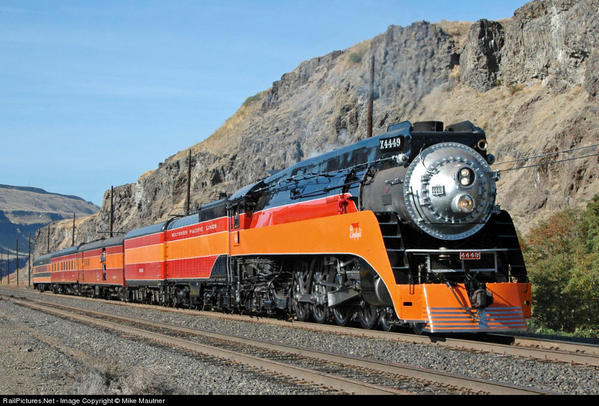
The funny thing to me about it is I see three different shades of Daylight. The engine and tender are one shade, the auxiliary tender is slightly lighter, and then the two passenger cars are noticeably darker. Almost like how my bright Lionel GS-2 looks with the more mellow GGD cars ![]()
This begs another question - did the original daylights run with auxiliary tenders painted to match or was that just a feature of the excursions?
You simply cannot match colors to a photo. There are far too many variables. That is why color charts are actual paint swatches glued on to the paper.
now, back to the Shasta Daylight for a minute:
All coaches, diners and tavern cars had larger picture windows.[1]:92 The cars did not have the fluted panels seen on prewar Daylights, but the two Parlor Lounge Observation cars (built in 1941 and refurbished for service on the new Shasta Daylight) retained their side fluting and their standard-sized windows. For visual unity along the train the above-window paint stripe continued at the high-window height along these cars.
That is from Wikipedia - but it is backed up with a lot of reference materials. The Wright book was no help, but the Morning Sun SP Color Guide backs up the Wiki quote. So, those of you fretting about the red color on the model Shasta cars - they are not Shasta cars anyway, so why worry about it.
Back to the Napoleon Hat truck. In a minute.
This begs another question - did the original daylights run with auxiliary tenders painted to match or was that just a feature of the excursions?
The Southern Pacific did not have ANY auxiliary tenders for their main line steam locomotives, Daylights or otherwise.
Here is a very poor reproduction of a photo of the real truck - a class 4TC6:
Note that where the coil spring lands, the casting does not have a bulge to match.
Here are a couple of O Scale trucks:
These are Wasatch trucks, and the only flaw in these beauties is the ears on the main casting slope down a bit. Almost unnoticeable. The Sunset trucks are quite good - I have a photo of the NYC version - but they all have a cylindrical bulge onnthe truck journal box casting where the coil spring lands. The Wasatch trucks cost as much as the entire GGD car, so the best deal in town is still the GGD. That's an opinion, of course.
That is an auxiliary tender in the excursion photos though, right? In any event thanks for confirming the original Daylights didn't have them; I was considering purchasing the MTH model for my GS-2 but I can scrap that idea now.
That is an auxiliary tender in the excursion photos though, right?
Correct. That auxiliary tender was rebuilt from a Cab Forward tender, #4219 to be exact, specifically for the New Orleans Worlds Fair Daylight trip in 1984. SP4449 has used that auxiliary tender ever since, however sometimes it was repainted to black, but then re-repainted to Red & Orange Daylight to match the main tender.
Yep, that is what that is. As for the earlier photo I posted, that is why I chose it, the color appears or actually does vary some car to car. Either way the actual chips are the best bet in terms of accuracy, now as for what lighting conditions, road grime and other variables do to the final look is another question. ![]()
There are also some good photos of observation cars at this site.
Or how about black....
Attachments
These are Wasatch trucks, and the only flaw in these beauties is the ears on the main casting slope down a bit. Almost unnoticeable. The Sunset trucks are quite good - I have a photo of the NYC version - but they all have a cylindrical bulge onnthe truck journal box casting where the coil spring lands. The Wasatch trucks cost as much as the entire GGD car, so the best deal in town is still the GGD. That's an opinion, of course.
Aha, I see what you mean now Bob. For me at least, like the little discrepancy in the Wasatch trucks it's barely noticeable.
I am a real fan of what Scott is doing. He has moved the O Scale hobby significantly toward realism. When I start rivet counting, it is for future reference, not a criticism of what is actually available. If you are a Daylight freak, like me, you are so much better off now than at any time in the past. These GGD cars are great.
With a serious dial indicator, a broadside photo, and a little algebra I came up with the following:
In O Scale, the real letterboard is .189" high. The Speer letterboard is only 81% of that, at .154"
The real window area scales out at .695" – Speer is 96% of that, at .665".
All other aspects are darn near perfect - the flaw is at the flat portions did not go all the way to the peak of the first narrow corrugation above the flat area. Easy mistake to make, and actually correctible with body putty if one is of a mind (semi-nuts?).
I personally will go for alternating corrugations - but if I were starting over, I might opt for GGD for the entire train.
A wise law prof once told me something about repeating myself - he was trying to discourage me. This needs to be said again:
You cannot conclude anything about color from a photograph, a printed copy of a photo, or a digital photo on a computer screen. You cannot. Not opinion!
And let me repeat myself too - Thank you Bob for continuing to contribute such great info to this discussion! ![]()
Originally Posted by bob2:
You cannot conclude anything about color from a photograph, a printed copy of a photo, or a digital photo on a computer screen. You cannot. Not opinion!
I'll bet the editors of Smithsonian, National Geographic, and countless other publications, as well as graphics people and scientists, among many others, would be interested in hearing that! ![]()
Leaving all that aside, though, and not using photos but just verbal description from an expert (Hot Water), the correct Daylight paints are bright, and they now use Imron paints that don't fade and retain that brightness, and these colors are based on the original Daylight colors used by the SP. Some early photos of Daylight equipment that was painted before Imron paint was used, may show paint that had faded out from the bright colors that were originally applied by the SP, due to weathering. As he notes:
"May I point out that SP4449 has ALWAYS been painted with Dupont Imron paint, which was manufactured to the original enamel & lacquer based paints used in the 1930s, 1940s, 1950s, and 1960s. That Dupont Imron is impervious to ANY solvent/cleaning agent, including lacquer thinner, diesel fuel, mineral spirits, gasoline, and Dawn dishwashing soap! Absolutely NOTHING cuts nor effects the shine of that Dupont Imron product, and that is one reason she always looks so "bright", as compared to photos of SP GS Class Daylight locomotives, that have faded, from the 1940s and 1950s."
So historically, based on Hot Water's comments, it appears that the bright Daylight paint used by Friends of 4449, as shown at their website, is correct, and represents the colors actually used by SP going back to the 1930s and 40s, which gives a starting point for accuracy. However, duller paint tones could be found on older (pre-Imron paint) Daylight equipment that had experienced fade from exposure which subdued the original Daylight paint.
For hobbyists (at least for those to whom it matters), for modeling older Daylight equipment, it appears that while the original paints as applied were bright shades, more faded and weathered shades on equipment that had been in service for awhile are also going to be prototypical. Same as with any railroad. (And with people. ![]() )
)
I do not subscribe to Smithsonian or National Geographic. Too bad Morning Sun and Four Ways West do not have access to this wonderful new technology, because if they did we could have accurate reproductions of some very old Kodak negatives, which are surely accurate in the infancy of color film.
As it is, you can find shots of Daylight equipment in Dunsmuir and San Luis Obispo beautifully preserved in print. The color differences, even of the same car on the same day from different angles, are impressive.
Respectfully, this is not a controversy I am interested in, since I shoot everything with Scale Coat and am happy. But I bet Hot could get some samples of actual paint - and you would have your answer. I do have the Lark color swatches from 1950, but the red is not there. Next time Doyle fires up the old spray gun, have him shoot some white card stock for the gift shop.
Good enough for me!
I do not subscribe to Smithsonian or National Geographic. Too bad Morning Sun and Four Ways West do not have access to this wonderful new technology, because if they did we could have accurate reproductions of some very old Kodak negatives, which are surely accurate in the infancy of color film.
As it is, you can find shots of Daylight equipment in Dunsmuir and San Luis Obispo beautifully preserved in print. The color differences, even of the same car on the same day from different angles, are impressive.
I appreciate your comments, Bob, and you're certainly correct about this. Variations in shooting conditions and technology made for wide variances. As far as model trains, I guess there's no better example of photo color shade differences and confusion than that story of how Lionel's black Warbonnets came to be.....that it was because the angle of the photograph they used made the stainless steel sides look like they were black.
As to this Daylight color sleuthing, I was just trying to figure out what the correct starting point was in all this. It isn't easy, given the many conflicting statements that have been made about this. Based on comments, it seems clear that the current 4449 with its lustrous finish and colors is correct (as we would hope it would be!), and other color shades that might be perceived in photos or elsewhere are a result of either 1) particular light shade angles due to conditions when the photo was made; 2) aging of the print; or 3) the railroad equipment itself had faded paint due to weathering at the time the photo was made. Or at least that's what I think the conclusion is.![]()
![]()
It would be nice if the model manufacturers would "check the memo" on this, but they won't.![]() Obviously the Daylight colors they use vary a great deal, and no doubt will continue to do so.
Obviously the Daylight colors they use vary a great deal, and no doubt will continue to do so.
So why is the total inaccuracy of the Shasta Daylight models overlooked, while this easily resolved glitch receives all the attention?
You have to understand, I have excellent smooth side blanks and a mill, and I personally could have an accurate Shasta with very little effort. Well, you really do not have to understand, but can you see why I am puzzled?
A repaint is simply trivial. I am not a skilled painter, but there are a few out there who do not charge anything near what their time is worth. If a color bothers you, change it. On the other hand, no amount of skill would convert a Coast Daylight car to a Shasta Daylight car, with the exception of the observation car.




